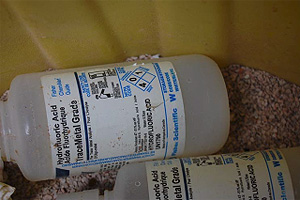Improper handling of nitric acid waste damages a cabinet and scatters glass shards throughout laboratoryPage Title
What happened?
Graduate students were performing a procedure they had used successfully in the past. The procedure used four materials: nitric acid, hydrofluoric acid, hydrochloric acid and peroxide, and hydrofluoric acid with ethanol. At the end of the procedure, they disposed of each material in a separate waste bottle in a cabinet beneath the hood.
Several hours after the procedure ended, after the students had left the lab, a waste bottle exploded. The blast blew open the doors to the cabinet and propelled 0.5 inch glass shards about 35 feet over the length and breadth of the lab. No one was in the lab, and there were no injuries. The Lubbock Fire Department (LFD) and HAZMAT team responded and cleaned up the laboratory.

Area where incident occurred before LFD HAZMAT team cleanup.

One of two 500 ml bottles of nitric acid that were broken.

Two 500 ml bottles of hydrofluoric acid that were punctured.

Red dots on floor indicate glass shards at the end of the lab farthest from explosion
in the hood.
What was the cause?
The explosion was likely caused by a reaction between nitric acid and ethanol, created when nitric acid waste was mixed with the hydrofluoric acid + ethanol waste. These wastes were mixed in a glass bottle, the expected oxidative reaction occurred, pressure built up, and the bottle exploded. This is the reaction expected when nitric acid is combined with organics – no surprises at all.
Why did the wastes get mixed together? Likely reasons:
- The waste bottle was not externally polymer coated (which could have minimized glass fragmentation in the event the bottles were over-pressured or dropped).
- The waste bottle label was not color-coded to indicate the type of waste present in each container.
- The waste bottle did not have a venting cap that could have mitigated over-pressurization.
- The top of the lab waste storage bottle was very tightly capped, which could have result in over-pressurization and catastrophic failure of the bottle.
- The experimenters may have not understood the printed text on the laboratory waste bottle. S/he may not have understood chemical names printed in English.
What corrective actions were taken?
EH&S closed the laboratory, reviewed chemical storage and waste handling procedures with the students and PIs, and retrained laboratory personnel in appropriate handling, storage, and waste procedures for nitric acid.
Extensive guidance about waste handling was provided to the TTU community via e-mails and a website story about hazardous waste procedures:
- Memo on Waste Storage – Jan. 17, 2012
- Interim Guidance for Handling and Storing Chemical Waste at TTU – Jan. 17, 2012
How can we prevent incidents like this?
- EH&S needs to provide clear guidance about waste handling.
- Faculty and lab chiefs need to provide each student with specific training about how to handle the chemicals and wastes present in their laboratories.
- Students working with their faculty advisors and EH&S need to prepare a waste stream plan for each procedure they’re going to carry out.
- Each laboratory group needs to prepare written waste handling SOPs that describe specific procedures for handling each waste generated during procedures.
- Faculty and students need to label and segregate waste, label waste containers clearly (color helps!) arrange materials to ensure segregation by hazards and incompatibilities.
Resources
- Bretherick’s Handbook of Reactive Chemical Hazards, 6th Edition, P.G. Urben, ed., 1999
- Prudents Practices in the Laboratory, Handling and Management of Chemical Hazards, National Research Council, 2011
Environmental Health & Safety
-
Address
Texas Tech University, 407 Flint Ave, Lubbock, TX 79409 (Mail Stop 1090) -
Phone
806.742.3876 -
Email
safety@ttu.edu
